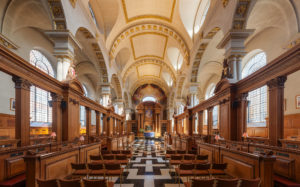
Queen Victoria died in 1901, after the longest reign by any British monarch (a record broken only by Queen Elizabeth II). To honor her memory, a memorial was designed that same year. The central monument – what most tourists think of as the Victoria Memorial– was constructed between 1906 and 1911. The memorial was not completed until 1924.
The entire semi-circular design as constructed in front of Buckingham Palace includes the Dominion Gates (the Canada Gate, the Australia Gate, and the South and West Africa Gates); the Memorial Gardens; and the central monument, built of 2,300 tons of Carrara marble and comprised of the monument atop a staired terrace.

Many a time have I walked around those gardens and not realized they’re part of the overall Victoria Memorial. They’re planted on a seasonal basis, with summer plantings including scarlet geraniums (to match the color of the uniforms of the Queen’s Guard), spider plants, salvias, and weeping figs. Winter plantings (for spring flowering) include yellow wallflowers and red tulips – some 50,000 of them.
The memorial plan required some rerouting of the streets in front of the palace and the shortening of The Mall. Thomas Brockwas chosen to be the designer. Funding was appropriated by Parliament and Dominion nations like Canada, Australia, New Zealand, and others contributed. In 1911, Mr. Brock was knighted for his service on the memorial.

During the unveiling ceremony that year, the two senior grandsons and their families attended – King George V of Britain and Kaiser Wilhelm II of Germany. Winston Churchill was Home Secretary at the time and had the duty of carrying the speeches to be given (as opposed to giving one himself).
This is the area where crowds gather for significant events in the life of Britain – the ending of World War II in Europe, coronations, royal weddings, and the Golden and Diamond Jubilees of Queen Elizabeth. This was also the area where the 2012 parade of the British Olympic and Paralympic teams ended, following a route through the City of London, the Strand and Trafalgar Square, and The Mall. (My wife and I watched the parade on the Strand across the street from Charing Cross Station.)
The memorial area has also seen its fair share of protests, including the Million Mask March in November 2013 when the Memorial area was damaged.

In Dancing King, the Victoria Memorial area is the setting for a critical scene, perhaps thepivotal scene of the novel. The memorial was chosen for the scene because of all the royal connections. Michael Kent-Hughes meets with protesters inside the palace, while crowds gather in front and watch the televised meeting on mobile phones and tablets. Michael doesn’t bend an inch in regard to the protesters’ demands, and his polite but firm statements are met with cheers and roars from the crowd in front.
When the meeting ends, Michael tells his security people that, while he knows the risks, he’s going outside the palace to “meet with my people.” From that point on, the story – Michael’s story and Britain’s story – changes.
Just how much it changes will be seen in book four (in process) and book five (planned).
Top photograph: a panoramic view of the gardens, monument, and Buckingham Palace.














